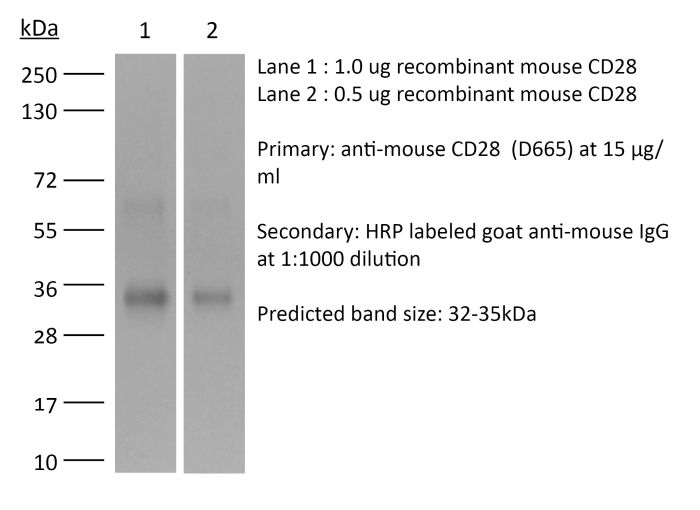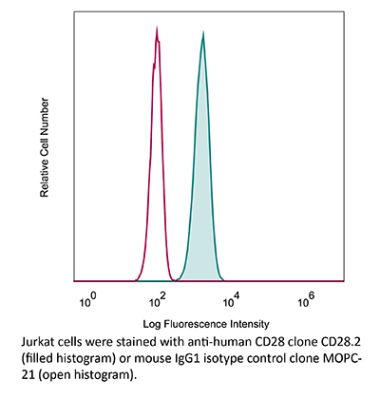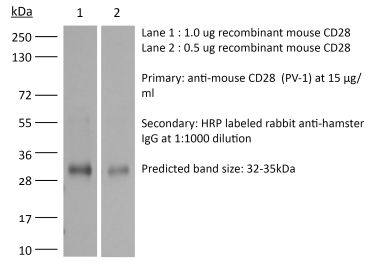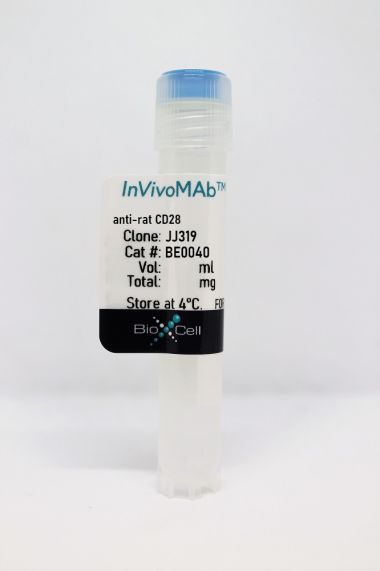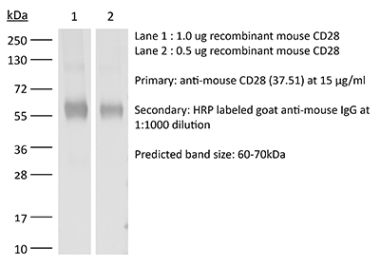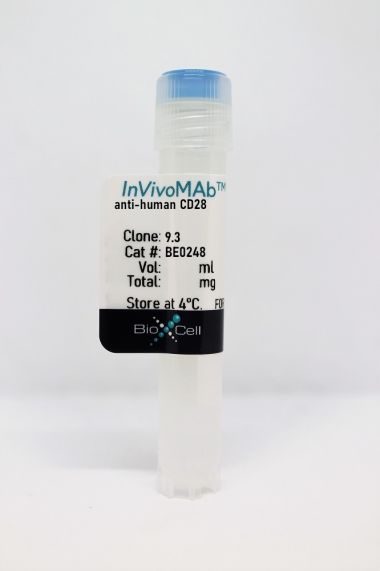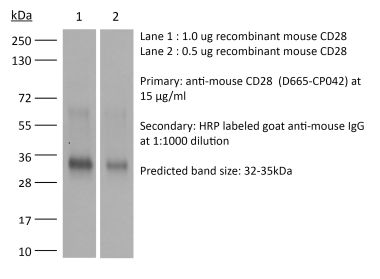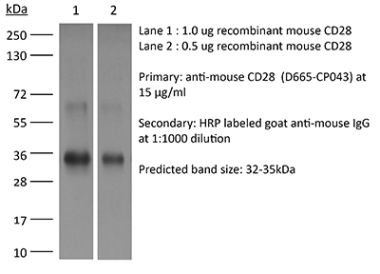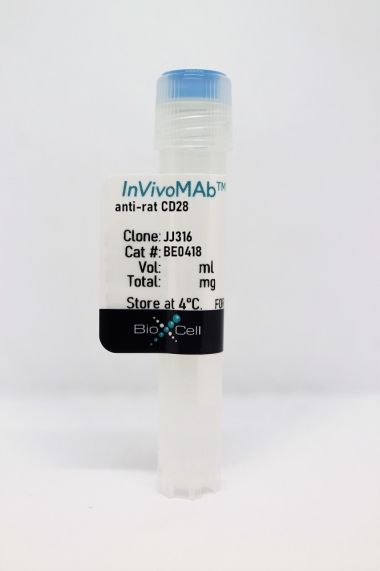InVivoMAb anti-mouse CD28
Product Details
The D665 monoclonal antibody reacts with mouse CD28, a 45 kDa costimulatory receptor and a member of the Ig superfamily. CD28 is expressed by thymocytes, most peripheral T cells, and NK cells. CD28 is a receptor for CD80 (B7-1) and CD86 (B7-2). Signaling through CD28 induces IL-2 and IL-2 receptor expression and T cell proliferation. The D665 antibody is a CD28 superagonist and is most commonly used to induce the expansion of Treg cells in vivo in various mouse models of disease.Specifications
| Isotype | Mouse IgG1, κ |
|---|---|
| Recommended Isotype Control(s) | InVivoMAb mouse IgG1 isotype control, unknown specificity |
| Recommended Dilution Buffer | InVivoPure pH 7.0 Dilution Buffer |
| Conjugation | This product is unconjugated. Conjugation is available via our Antibody Conjugation Services. |
| Immunogen | A20 cells expressing mouse CD28 and a recombinant mouse CD28-Ig fusion protein |
| Reported Applications |
in vivo T cell stimulation/activation in vitro T cell stimulation/activation |
| Formulation |
PBS, pH 7.0 Contains no stabilizers or preservatives |
| Endotoxin |
<2EU/mg (<0.002EU/μg) Determined by LAL gel clotting assay |
| Purity |
>95% Determined by SDS-PAGE |
| Sterility | 0.2 µm filtration |
| Production | Purified from cell culture supernatant in an animal-free facility |
| Purification | Protein G |
| RRID | AB_2819055 |
| Molecular Weight | 150 kDa |
| Storage | The antibody solution should be stored at the stock concentration at 4°C. Do not freeze. |
Additional Formats
Recommended Products
in vivo T cell stimulation/activation
Win, S. J., et al. (2016). "In vivo activation of Treg cells with a CD28 superagonist prevents and ameliorates chronic destructive arthritis in mice" Eur J Immunol 46(5): 1193-1202. PubMed
Although regulatory T (Treg) cells are necessary to prevent autoimmune diseases, including arthritis, whether Treg cells can ameliorate established inflammatory disease is controversial. Using the glucose-6-phosphate isomerase (G6PI)-induced arthritis model in mice, we aimed to determine the therapeutic efficacy of increasing Treg cell number and function during chronic destructive arthritis. Chronic destructive arthritis was induced by transient depletion of Treg cells prior to immunization with G6PI. At different time points after disease induction, mice were treated with a CD28 superagonistic antibody (CD28SA). CD28SA treatment during the induction phase of arthritis ameliorated the acute signs of arthritis and completely prevented the development of chronic destructive arthritis. CD28SA treatment of mice with fully developed arthritis induced a significant reduction in clinical and histological signs of arthritis. When given during the chronic destructive phase of arthritis, 56 days after disease induction, CD28SA treatment resulted in a modest reduction of clinical signs of arthritis and a reduction in histopathological signs of joint inflammation. Our data show that increasing the number and activation of Treg cells by a CD28SA is therapeutically effective in experimental arthritis.
in vivo T cell stimulation/activation
Schmidt, T., et al. (2016). "Induction of T regulatory cells by the superagonistic anti-CD28 antibody D665 leads to decreased pathogenic IgG autoantibodies against desmoglein 3 in a HLA-transgenic mouse model of pemphigus vulgaris" Exp Dermatol 25(4): 293-298. PubMed
Pemphigus vulgaris (PV) is a potentially life-threatening autoimmune disease of the skin and mucous membranes. Its pathogenesis is based on IgG autoantibodies that target the desmosomal cadherins, desmoglein 3 (Dsg3) and desmoglein 1 (Dsg1) and induce intra-epidermal loss of adhesion. Although the PV pathogenesis is well-understood, therapeutic options are still limited to immunosuppressive drugs, particularly corticosteroids, which are associated with significant side effects. Dsg3-reactive T regulatory cells (Treg) have been previously identified in PV and healthy carriers of PV-associated HLA class II alleles. Ex vivo, Dsg3-specific Treg cells down-regulated the activation of pathogenic Dsg3-specific T-helper (Th) 2 cells. In this study, in a HLA-DRB1*04:02 transgenic mouse model of PV, peripheral Treg cells were modulated by the use of Treg-depleting or expanding monoclonal antibodies, respectively. Our findings show that, in vivo, although not statistically significant, Treg cells exert a clear down-regulatory effect on the Dsg3-driven T-cell response and, accordingly, the formation of Dsg3-specific IgG antibodies. These observations confirm the powerful immune regulatory functions of Treg cells and identify Treg cells as potential therapeutic modulators in PV.
in vivo T cell stimulation/activation
Schuhmann, M. K., et al. (2015). "CD28 superagonist-mediated boost of regulatory T cells increases thrombo-inflammation and ischemic neurodegeneration during the acute phase of experimental stroke" J Cereb Blood Flow Metab 35(1): 6-10. PubMed
While the detrimental role of non-regulatory T cells in ischemic stroke is meanwhile unequivocally recognized, there are controversies about the properties of regulatory T cells (Treg). The aim of this study was to elucidate the role of Treg by applying superagonistic anti-CD28 antibody expansion of Treg. Stroke outcome, thrombus formation, and brain-infiltrating cells were determined on day 1 after transient middle cerebral artery occlusion. Antibody-mediated expansion of Treg enhanced stroke size and worsened functional outcome. Mechanistically, Treg increased thrombus formation in the cerebral microvasculature. These findings confirm that Treg promote thrombo-inflammatory lesion growth during the acute stage of ischemic stroke.
in vitro T cell stimulation/activation
Dennehy, K. M., et al. (2006). "Cutting edge: monovalency of CD28 maintains the antigen dependence of T cell costimulatory responses" J Immunol 176(10): 5725-5729. PubMed
CD28 and CTLA-4 are the major costimulatory receptors on naive T cells. But it is not clear why CD28 is monovalent whereas CTLA-4 is bivalent for their shared ligands CD80/86. We generated bivalent CD28 constructs by fusing the extracellular domains of CTLA-4 or CD80 with the intracellular domains of CD28. Bivalent or monovalent CD28 constructs were ligated with recombinant ligands with or without TCR coligation. Monovalent CD28 ligation did not induce responses unless the TCR was coligated. By contrast, bivalent CD28 ligation induced responses in the absence of TCR engagement. To extend these findings to primary cells, we used novel superagonistic and conventional CD28 Abs. Superagonistic Ab D665, but not conventional Ab E18, predominantly ligates CD28 bivalently at low CD28/Ab ratios and induces Ag-independent T cell proliferation. Monovalency of CD28 for its natural ligands is thus essential to provide costimulation without inducing responses in the absence of TCR engagement.
- In Vitro,
- Mus musculus (House mouse),
- Stem Cells and Developmental Biology
Promoting Effect of L-Fucose on the Regeneration of Intestinal Stem Cells through AHR/IL-22 Pathway of Intestinal Lamina Propria Monocytes.
In Nutrients on 12 November 2022 by Tan, C., Hong, G., et al.
PubMed
The recovery of the intestinal epithelial barrier is the goal for curing various intestinal injurious diseases, especially IBD. However, there are limited therapeutics for restoring intestinal epithelial barrier function in IBD. The stemness of intestinal stem cells (ISCs) can differentiate into various mature intestinal epithelial cells, thus playing a key role in the rapid regeneration of the intestinal epithelium. IL-22 secreted by CD4+ T cells and ILC3 cells was reported to maintain the stemness of ISCs. Our previous study found that L-fucose significantly ameliorated DSS-induced colonic inflammation and intestinal epithelial injury. In this study, we discovered enhanced ISC regeneration and increased intestinal IL-22 secretion and its related transcription factor AHR in colitis mice after L-fucose treatment. Further studies showed that L-fucose promoted IL-22 release from CD4+ T cells and intestinal lamina propria monocytes (LPMCs) via activation of nuclear AHR. The coculture system of LPMCs and intestinal organoids demonstrated that L-fucose stimulated the proliferation of ISCs through an indirect manner of IL-22 from LPMCs via the IL-22R-p-STAT3 pathway, and restored TNF-α-induced organoid damage via IL-22-IL-22R signaling. These results revealed that L-fucose helped to heal the epithelial barrier by accelerating ISC proliferation, probably through the AHR/IL-22 pathway of LPMCs, which provides a novel therapy for IBD in the clinic.
- In Vitro,
- Mus musculus (House mouse),
- Immunology and Microbiology
SOX-5 activates a novel RORγt enhancer to facilitate experimental autoimmune encephalomyelitis by promoting Th17 cell differentiation.
In Nature Communications on 20 January 2021 by Tian, Y., Han, C., et al.
PubMed
T helper type 17 (Th17) cells have important functions in the pathogenesis of inflammatory and autoimmune diseases. Retinoid-related orphan receptor-γt (RORγt) is necessary for Th17 cell differentiation and functions. However, the transcriptional regulation of RORγt expression, especially at the enhancer level, is still poorly understood. Here we identify a novel enhancer of RORγt gene in Th17 cells, RORCE2. RORCE2 deficiency suppresses RORγt expression and Th17 differentiation, leading to reduced severity of experimental autoimmune encephalomyelitis. Mechanistically, RORCE2 is looped to RORγt promoter through SRY-box transcription factor 5 (SOX-5) in Th17 cells, and the loss of SOX-5 binding site in RORCE abolishes RORCE2 function and affects the binding of signal transducer and activator of transcription 3 (STAT3) to the RORγt locus. Taken together, our data highlight a molecular mechanism for the regulation of Th17 differentiation and functions, which may represent a new intervening clue for Th17-related diseases.
- FC/FACS,
- Mus musculus (House mouse),
- COVID-19,
- Immunology and Microbiology
Development of a multi-antigenic SARS-CoV-2 vaccine candidate using a synthetic poxvirus platform.
In Nature Communications on 30 November 2020 by Chiuppesi, F., Salazar, M. d., et al.
PubMed
Modified Vaccinia Ankara (MVA) is a highly attenuated poxvirus vector that is widely used to develop vaccines for infectious diseases and cancer. We demonstrate the construction of a vaccine platform based on a unique three-plasmid system to efficiently generate recombinant MVA vectors from chemically synthesized DNA. In response to the ongoing global pandemic caused by SARS coronavirus-2 (SARS-CoV-2), we use this vaccine platform to rapidly produce fully synthetic MVA (sMVA) vectors co-expressing SARS-CoV-2 spike and nucleocapsid antigens, two immunodominant antigens implicated in protective immunity. We show that mice immunized with these sMVA vectors develop robust SARS-CoV-2 antigen-specific humoral and cellular immune responses, including potent neutralizing antibodies. These results demonstrate the potential of a vaccine platform based on synthetic DNA to efficiently generate recombinant MVA vectors and to rapidly develop a multi-antigenic poxvirus-based SARS-CoV-2 vaccine candidate.
- Biochemistry and Molecular biology,
- Cell Biology,
- Immunology and Microbiology
Acylglycerol Kinase Maintains Metabolic State and Immune Responses of CD8+ T Cells.
In Cell Metabolism on 6 August 2019 by Hu, Z., Qu, G., et al.
PubMed
CD8+ T cell expansions and functions rely on glycolysis, but the mechanisms underlying CD8+ T cell glycolytic metabolism remain elusive. Here, we show that acylglycerol kinase (AGK) is required for the establishment and maintenance of CD8+ T cell metabolic and functional fitness. AGK deficiency dampens CD8+ T cell antitumor functions in vivo and perturbs CD8+ T cell proliferation in vitro. Activation of phosphatidylinositol-3-OH kinase (PI3K)-mammalian target of rapamycin (mTOR) signaling, which mediates elevated CD8+ T cell glycolysis, is tightly dependent on AGK kinase activity. Mechanistically, T cell antigen receptor (TCR)- and CD28-stimulated recruitment of PTEN to the plasma membrane facilitates AGK-PTEN interaction and AGK-triggered PTEN phosphorylation, thereby restricting PTEN phosphatase activity in CD8+ T cells. Collectively, these results demonstrate that AGK maintains CD8+ T cell metabolic and functional state by restraining PTEN activity and highlight a critical role for AGK in CD8+ T cell metabolic programming and effector function. Copyright © 2019 Elsevier Inc. All rights reserved.
- In Vivo,
- Mus musculus (House mouse),
- Immunology and Microbiology
Laboratory mice born to wild mice have natural microbiota and model human immune responses.
In Science on 2 August 2019 by Rosshart, S. P., Herz, J., et al.
PubMed
Laboratory mouse studies are paramount for understanding basic biological phenomena but also have limitations. These include conflicting results caused by divergent microbiota and limited translational research value. To address both shortcomings, we transferred C57BL/6 embryos into wild mice, creating "wildlings." These mice have a natural microbiota and pathogens at all body sites and the tractable genetics of C57BL/6 mice. The bacterial microbiome, mycobiome, and virome of wildlings affect the immune landscape of multiple organs. Their gut microbiota outcompete laboratory microbiota and demonstrate resilience to environmental challenges. Wildlings, but not conventional laboratory mice, phenocopied human immune responses in two preclinical studies. A combined natural microbiota- and pathogen-based model may enhance the reproducibility of biomedical studies and increase the bench-to-bedside safety and success of immunological studies. Copyright © 2019 The Authors, some rights reserved; exclusive licensee American Association for the Advancement of Science. No claim to original U.S. Government Works.

